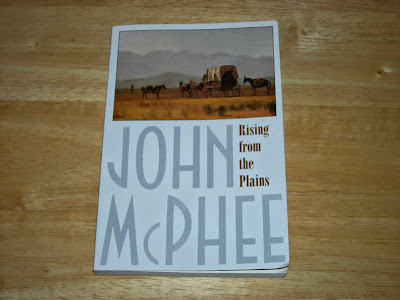The Bookworm: Rising from the Plains
Rising from the Plains, by John McPhee. 198 pages. Farrar, Straus and Giroux. 1986.
We were looking at many moments in well over half the existence of the earth, and were seeing — as it happened — a good deal more time than one sees in the walls of the Grand Canyon, where the clock stops at the rimrock, aged two hundred and fifty million years. The rock before us here at Rawlins reached back into the Archean Eon and up to the Mocene epoch. Any spendthrift with a camera could aim it into that scene and — in a two-hundred-and-fiftieth of a second at f/16 — capture twenty-six hundred million years. (p. 22)
The weekend would not pass without me finishing Rising from the Plains by John McPhee.
McPHEE!
Rising from the Plains is another installment of McPhee’s geological chronicle of North America. This time his focus is Wyoming, a state McPhee writes, “suggests with emphasis the page-one principle of reading in rock the record of the earth: Surface appearances are only that; toography grows, shrinks, compresses, spreads, disintegrates, and disappears; every scene is temporary, and is composed of fragments from other scenes” (p. 27).
Accompanied by David Love, a preeminent geologist who grew up smack dab in the middle of the Equality State’s mountains, valleys, and holes, McPhee travels from one end of the state to the other along Interstate 80 to inspect road cuts that expose Wyoming’s enigmatic geological history. From the famous “Gangplank” between Cheyenne and Laramie (where “as nowhere else, you can step off the Great Plains directly onto a Rocky Mountain summit” (p. 50)), the former bed of Lake Gosiute, and the oil boom-lands in the west near the Utah border, McPhee waxes poetic and geological about Wyoming’s landscape. Slowly, with the help of Love’s insights, field work, and the then-emerging theory of plate tectonics, McPhee explains how the state came to be the way it is today.
Braided with McPhee and Love’s trip through the state is an amazing history of Love’s family. The book beings with Love’s mother, Ethel Waxman, arriving on a train in Rawlins. She had taken a job as the schoolmistress at Red Bluff Ranch in the state’s expansive and sparsely populated middle. McPhee drops in excerpts from Waxman’s unpublished diaries about her rough and dangerous ride by stagecoach over the mountains to her new home, her pupils, and the people she encountered at the ranch and their peculiar ways — including Johnny Love, a Scotsman with a massive ranch who had slept out in the open, without any shelter, for seven years. Eventually, Waxman marries Love and she moves to his ranch, continuing her diary to document their life and family. Her vignettes of ranch life are incredible. In fact, I came away with the impression that Love’s mother was a better writer than McPhee. She at least did not get caught up in the obscure technical minutia of the Laramide orogeny. My favorite excerpt was her description of the cowboys who worked on the ranch:
Most were homely, with prematurely lined faces but with lively eyes that missed little. None wore glasses; people with glasses went into other kinds of work. Many were already stooped from chronic saddle-weariness, bowlegged, hip-sprung, with unrepaired hernias that required trusses, and spinal injuries that required a “hanging pole” in the bunkhouse. This was a horizontal bar from which the cowboys would hang by their hands for 5–10 minutes to relieve pressure on ruptured spinal disks that came from too much bronc-fighting. Some wore eight-inch-wide heavy leather belts to keep their kidneys in place during prolonged hard rides. (pp. 82–83)
Her accounts and descriptions were real and raw, and I savored each one because I knew McPhee would go on and on in the next chapter about such-and-such a rock here or such-and-such a rock there.
Rising from the Plains was a tedious read at times. The pace is often mired in geology-speak, and McPhee’s descriptions often go right over ones head, tossing hair this way and that like Wyoming’s vicious winds. I’m sorry, but I am not a rock-head and am not well-versed in the plethora or rock types, how they are made, and the clues they offer about a region’s past. That is what I really do not like about these installments of the Annals of the Former World: despite being fantastic and very interesting at times, the writing can be too esoteric. (Speaking of the Annals of the Former World, our landlord kindly lent me his hardcover copy a few years ago. I was reading something by McPhee at the time and I guess he thought I would like to borrow Annals. It hung around as a paperweight in my room and in our kitchen for a year before I eventually gave it back to him.) Rising from the Plains, I felt, was much more technical and nerdy than Basin and Range, the only other one of McPhee’s geological histories I have read. (I thought I had read In Suspect Terrain, but apparently not.)
Needless to say, I will never think of Wyoming the same way again. (I have, unfortunately, never been to Wyoming and really do not have much of an opinion of the state. I would, of course, like to see if for myself, especially the Gangplank. I suppose one could consider Rising from the Plains a massive and sometimes inaccessible tour guide.) However, I will be reluctant to tackle another of McPhee’s geological histories. I’ll probably do it at some point, though, since I have read two-fifths of Annals. (I may as well buy the damn thing because the fifth and last part was included and not printed individually.)


